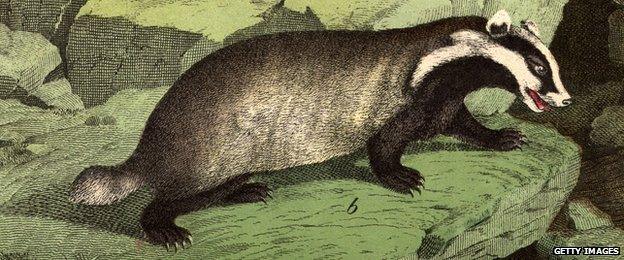Badgers: Splitting public opinion for more than 200 years
- Published
- comments

When it comes to a cull of badgers, it seems no amount of science will resolve the arguments.
A researcher who studied their role in popular culture has warned that politicians have not grasped the true nature of the cull controversy.
Dr Angela Cassidy from Imperial College London researched discourse on badgers, external from the end of the 18th Century.
She told BBC News that they have consistently divided opinion, with farmers wanting rid of them and animal lovers seeking to protect them.
Dr Cassidy said that bombarding people with science about TB in the animals would fail, as the debate was really about emotions and values.
"The sides have a very different understanding of what the countryside is for and how we should treat animals," she said.
"That's why I think one of the reasons why the focus on the evidence isn't getting us that far is because it can be interpreted in different ways and what we have to acknowledge is that there are different values going on, and this is a very political debate."
Pest or pet?
A Defra source told BBC News that some civil servants working on the badger issue acknowledged that people had very different views of whether farmers had a right to control badgers, or whether wildlife was in some way "owned" by everyone.
Dr Cassidy discovered a divide stretching more than 200 years in the columns of The Times.
"Every so often I found these little flurries of correspondence between people arguing whether badgers were pests or likeable animals. This sort of thread pops up every 20 or 30 years.
"There's a link consistently about how people were talking about badgers then and now. When people were talking about liking badgers they would talk about them being clean domestic animals, very houseproud and family-oriented.
"People not liking badgers talked about them being dirty and disruptive. It's the same now."
She says the defining characterisation of the animals in the 20th Century was framed by Kenneth Graham's classic The Wind in the Willows with its gruff, wise, brave Badger.
The book was last made into a movie in 2006 and Amanda Craig, children's book critic for The Times, told BBC News that it has been massively influential for generations.
'Bunny eaters'
"Badger is the ultimate moral authority, portrayed as a rough but very kindly Tory gentleman. He has this speech about how badgers always endure - people come and go," says Ms Craig.
"You think of Badger a bit like an ideal father - someone who's going to protect you; a great comfort figure as well as an authority figure.
"You are likely to encounter Wind in the Willows somewhere between four and eight years old, so these creations are really important and influential - they really affect how we feel and see animals."
Dr Cassidy said a rare counter-example exists in Beatrix Potter's Tale of Mr Tod, in which Brock the badger plans to eat Benjamin Bunny's bunnies (bunny-eating is a genuine badger trait, as Potter - a countrywoman - would have known).
"This stands out because it's the only fictional portrayal I could find that has much in common with the older narrative about badgers as vermin which goes back to Tudor times," she said.
The most recent depictions have mostly been comic portrayals in cartoons, computer games and music videos like the 10-hour Badger Song, reputedly appreciated by students under the influence of substances.
The Environment Secretary Owen Paterson has accused people opposed to the cull of being seized by a "Wind in the Willows sentimentality".
But Dr Cassidy said it would be a mistake to confuse sentimentality with values.
"We have to take note of these cultural influences," said Dr Cassidy, whose research was funded by Nerc, the BBSRC. and the Rural Economy and Land Use Programme, external, which is itself part-funded by Defra.
"Both sides in the... debate use scientific argument to make the other side look bad. The values debate and the science are inextricably linked."
Follow Roger Harrabin on Twitter: @RogerHarrabin, external
- Published28 September 2012
- Published23 October 2012
- Published17 September 2012
- Published25 September 2012